Serviços Personalizados
Journal
Artigo
Indicadores
-
 Citado por SciELO
Citado por SciELO -
 Acessos
Acessos
Links relacionados
-
 Similares em
SciELO
Similares em
SciELO
Compartilhar
Etnográfica
versão impressa ISSN 0873-6561
Etnográfica vol.21 no.3 Lisboa out. 2017
ARTIGOS
African pastors and the religious (re)production of a visual culture
Pastores pentecostais africanos e a (re)produção religiosa de uma cultura visual
Rafael CazarinI
IDepartment of Sociology, University of the Basque Country UPV/EHU; ISOR – Research in Sociology of Religion, Autonomous University of Barcelona, Spain. E-mail:rafael.cazarin@ehu.eus
ABSTRACT
The (re)production of visual material is an extended practice amongst Pentecostal-Charismatics worldwide and church leaders seem to play a decisive role in engendering such practice. While promoting spiritual missions and institutional visions, pastors reinforce their personae in accordance to the spiritual gifts they perform. This article explores the forging of a visual culture that legitimates such performances, through the usage of posters and flyers which, it is argued, feature a particular speech. The arguments emerge from the observed cases of African pastors located in Spain and South Africa and the discovery of these visual representations through ethnographic fieldwork carried out between 2012 and 2015. The ascription of meaning to such materials is achieved by focusing on the graphic portrayal of emotions, religious experiences, ethos and morality, aligned with a somewhat African Pentecostal speech. It is suggested that, by engendering a speech community, this graphic language reflects the global and local quests for belonging faced by worshippers in the Diaspora.
Keywords: African Pentecostalism, Diaspora, media, migration, religious minorities
RESUMO
A (re)produção de material visual é uma prática generalizada entre pentecostais-carismáticos em todo o mundo e os líderes religiosos parecem ter um papel decisivo no estabelecimento dessa prática. Ao mesmo tempo que promovem missões espirituais e visões institucionais, estes pastores reforçam uma certa persona de acordo com os dons espirituais que performam. Este artigo interroga o uso de posters e folhetos como forma de legitimar tais performances, considerando que esses materiais veiculam um discurso característico. Os argumentos baseiam-se na observação de pastores africanos em Espanha e na África do Sul, realizada em trabalho de campo entre 2012 e 2015, através de estudos de caso que permitiram descobrir essas representações visuais. A atribuição de sentido a estes materiais é questionada a partir das representações imagéticas de certas emoções, experiências religiosas, ethos e moral, alinhadas com um certo discurso pentecostal africano. Propõe-se ainda que, ao engendrar uma comunidade discursiva, esta linguagem imagética reflete os desafios globais e locais vivenciados por pentecostais africanos na Diáspora.
Palavras-chave: pentecostalismo africano, diáspora, comunicação, migração, minorias religiosas
Introduction
Ethnography offers an optimal ground for articulating frames to see and to look at the construction of different symbolic universes (Sturken and Cartwright 2009; Cazarin and Davila 2014).[1] In this task, visual tools may work as an unexpected player and join in an ethnographic project that is already in progress, becoming, together with words, an equally meaningful element on the frame of – and for – reality (cf. Geertz 1973). Visual languages are able to frame and explore their own apprehensions of social realities by offering particular cognitive styles and ways of understanding and interpreting them, developing alternative objectives and methodologies (MacDougall 1997: 292-293). Moreover, these languages may lead to the fabrication of unconventional ways to see and to look at reality, to elaborate and construct knowledge.
In this vein, this article arises from the gradual acknowledgement of a vibrant visual culture while conducting participant observations in migrant initiated congregations located in Spain (Bilbao) and South Africa (Johannesburg). In both places, every Sunday morning, old warehouses, office spaces and emptied garages were filled with songs, dances and prayers, turning these secular buildings into life-changing religious temples. From 2012 to 2015, I followed the activities of six churches equally divided in both settings while particularly looking at the life stories of their leading pastors: Nigerian and Congolese nationals with geographically distant migratory processes that in the course of the fieldwork revealed similar religious responses to cultural and social adversities.
I took me no more than a couple of visits to the migrant neighbourhoods of Bilbao and Johannesburg to find the announcements of such services posted in ethnic shops, bars and random walls. Ads that highlight spiritual gifts of pastors as well as the typical Pentecostal experiences call the attention of the observer: healing, legal documents, miracles, poverty, these aspects are portrayed in posters and flyers in a call for transformation. These printed materials were collected during the fieldwork but were not initially the focus of analysis, only gradually did they come to integrate the corpus of ethnographic data generated through my fieldwork. Moreover, across journeys and destinations, the accomplishment of their roles involved south-south and south-north networks and exchanges of goods, speeches, behaviours, aesthetics and ideas.
The objective of this article is twofold: (1) to explore the uses and roles of images in printed materials elaborated in Pentecostal-Charismatic churches initiated by migrant pastors; (2) relatedly, to investigate the pastors construction of a Pentecostal speech throughout the African Diaspora. In particular, both lines of inquiry were informed by the abundant (re)production of visual materials and its usage as a means to construct an audio-visual culture that encompasses the religious experiences of African Pentecostals worldwide. The examination of these two dimensions led to three main topics to be explored in the following sections: (i) the use of captured images as part of sociograms (Bourdieu and Bourdieu 1965) or, in other words, how their use helps to enact or initiate a construct of collectivity in a trans-territorial geographical frame; (ii) the representation of codes, values, significant circumstances, lifestyles and rituals that engender an ethos for these communities; (iii) a potent dissemination of the pastors personal religious experience before, during and after the services.
Images and the word in the African Pentecostal Diaspora
Pentecostalism is historically a transnational phenomenon and, in its modern forms, it is glocally reproduced through a highly accelerated circulation of goods, ideas and people (Van Dijk 2002). In the second half of the 20th century, international conferences of African churches started to raise questions regarding the role of African missionaries saving the dark and dead West. Enacting cooperation, training, empowerment and networking amongst African churches throughout the Diaspora, these events played a significant part in structuring what would be called the reverse-mission. They were followed by a growing influx of missionaries and free-lance evangelists moving within migrant church networks and taking short-term positions as visitors (Adogame 2010).
Amongst the modern evangelistic strategies of Pentecostalism, televangelism is one that has been generating distinctive outputs. Throughout the 1990s and 2000s, a number of pastors (mainly North American) who became internationally renowned in the Pentecostal milieu paid regular visits to Africa and their TV shows were broadcast throughout the continent (Kalu 2003). In the same way, African televangelists are now (re)producing their own audio-visual and press material, as well as promoting international conferences where local, regional and international networks are established or reinforced. As pointed out by Anderson (2000), despite frequent criticism, such strategies have been successfully promoting a form of Christianity interconnected with an increasing flow of Western trends within African urban environments. Still, Pentecostalism illustrates how Africans have responded to the rapid changes in their socio-political and economic environment by simultaneously engendering a pan-African Christian message (Marshall-Fratani 1998). But how does this message operate in global and local dimensions, what are the mechanisms involved in this quest?
One of my experiences as participant observer in a Nigerian-led church in Bilbao helped me identify possible answers to this question. Apart from the recordings and photographs produced by the institution itself, the use of digital cameras by worshippers permeated the whole celebration, even if during the moments of prayer any other activity but praying ceased. Tablets and smartphones were some of the gadgets used as tools to record or capture the moments. The church also had a photographer and a cameraman available to record certain moments of the conference. Apostle Daniel, the church founder, explained that the tapes are used for the purpose of training and teaching skills to other pastors. He also disclosed the wish that one day these tapes would be sold to raise funds for the church, extend networks and broadcast evangelisation further.
I found similar experiences in almost all participant observations I did throughout three years in six different churches. The services were recorded by people with different positions in the congregation, some just worshippers, others from the media department or eventually training pastors. The actual destination of the produced material was not clearly defined by interviewees other than as an invitation for other people to come. Still, the videos recorded during certain events, conferences and church services, were said to be part of the educational material and / or for commercial purposes (for worshippers and other preachers).
As pointed out by Marshall-Fratani (1998: 300), the modern use of media and technology by Pentecostals is concerned with the dissemination of the word of God, making it an interesting and sensorial experience for people with different cultural backgrounds. Therefore, local religious events and celebrations may have a more extended influence than the immediate surroundings, since they may circulate across neighbourhoods, cities and even countries. The use of inanimate (i. e. musical instruments, projectors, cameras, etc.) and of animated mechanisms (body gestures, aesthetic styling) seem to converge towards a recognizable visual culture, no matter where congregants reside. As an occasional consumer of this visual culture, I noted the use of particular graphic patterns in the printed material (flyers, posters, booklets) found throughout geographically distant contexts: close-up shots on selected pastors or other leading figures, certain icons, words and expressions highlighted, images capturing emotional outbursts. All that seemed to evoke particular emotional states and aesthetics conflated into a sort of visual regime under the aegis of African Pentecostals church experiences. This conflation towards a visual regime is unfolded by Birgit Meyer (2015) as follows:
Pictures operate in the context of embodied, habitual practices of looking, display and figuration – a visual regime. In this process, there is a prime role for religion, involving notions of heaven and hell, good and evil, the beyond and the here and now, the spiritual and the physical, as well as a pantheon of spiritual beings and practices of revelation and concealment, in shaping visual regimes (2015: 335).
The graphic emphasis on emotions and body expressions is not particular to the cases I observed. The born-again experience recalled by Pentecostals presents itself with the purpose of integrating the body in Christian rituals (Baeta 1967; Gerloff 1999; Csordas 2002). Therefore, the idea of an intimate relationship with God becomes more of a non-textual experience, or at least not only depending on words, by integrating feelings to the liturgy (Hollenweger 2004: 133). But words are still important for Pentecostals and the strong reliance on the (re)production of social and individual narratives of transformation characterises the power of its speech.
In this regard, sociolinguists Dell Hymes (1974) and John Gumperz (1968) have developed the term speech community to describe a group of people who not only share a language and a vocabulary of reference but are also able to distinguish and adjust their own repertoires in different social interactions.[2] In other words, to speak a language correctly, one needs to learn its vocabulary and grammar, but also the context in which words are used:
A speech community is defined, then, tautologically but radically, as a community sharing knowledge of rules for the conduct and interpretation of speech. Such sharing comprises knowledge of at least one form of speech, and knowledge also of its patterns of use (Hymes 1974: 51).
The concept of speech community has also been developed in the field of sociolinguistics around the term discourse community (Duszak 1998; Omoniyi and Fishman 2006). According to John Swales (1990: 24-27), three aspects are to be highlighted in such communities: (1) the establishment of the group by a set of public goals; (2) the existence of a hierarchical structure based on the degree of competence of the community members; (3) the existence of discourse forms proper to the community. In this article, I relate these three aspects with the emergence of an African Pentecostal speech weaved in – and through – the (re)production of visual culture. After addressing (1) the set of public goals associated to the religious missions and church visions evoked by migrant pastors in Johannesburg and Bilbao as the core values of their work, I examine (2) the hierarchical structures of these churches, and (3) the visual forms of discourse evidenced in these contexts.
From missions / visions to a communal speech
The set of public goals is grounded on the very context where pastors and worshippers are immersed. The churches I observed in Spain and South Africa were equally initiated in the Diaspora. They shared similar socioeconomic conditions of the congregants – i. e. lower income status and undocumented migration –, spatial structures, hierarchical organization, and location. Far from the distinctive architecture of their well-established competitors, Catholic churches in Bilbao and classical Protestant churches in Johannesburg, these migrant-initiated churches seemed rather modest and transient. The services were mostly carried on in marginalized urban areas affected by violence, socioeconomic precariousness or immigration. These areas, migrant neighbourhoods of Bilbao and semi-peripheral suburbs of Johannesburg, are marked by diverse local dynamics amongst different groups of foreigners and with the surrounding society. Racism, xenophobia, police control, crime and social stigma of all sorts are experienced in the everyday lives of the residents in the vicinities of the churches.
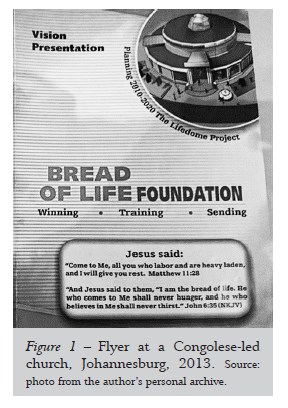
The urban marginality surrounding pastors and their congregations was also the reason evoked by church leaders to engage in what David Garbin described as a transformative project of spatial appropriation, regeneration and re-enchantment of the urban landscape (2013: 677). Their religious biographies were rather defined as missions and visions; leitmotifs and vocational duties to be pursued with the help of spiritual gifts. These gifts are interdependent and aim to a clear set of goals that starts with the spiritual transformation of individuals towards the moral regeneration of their immediate surroundings.
Young Evangelist Dennis explained some of these terms to me as his vision was helping him in the ongoing foundation of his own church. As a recent born-again, converted after a migration journey that had led him to Spain, he echoed other pastors understandings of the importance of a vision in structuring ones purpose while serving God:
The vision is responsibility, is to accept the responsibility and every pastor has his own. Thats why we do have confluences as pastors, evangelists, bishops, all kinds of Christians joined together. There are confluences at times, and also conventions where everybody gathers. So God gives you the vision, to one person, but he also uses everyone since everybody has different gifts. [ ] God gives a vision to one person but the fulfilment is for many people. God uses many people to fulfil the vision that he will give to the men of God. One pastor cannot be in Spain and in Canada at the same time. If there is a branch in Canada, it will be another pastor who will be there, so that is why we train leaders and many people who are also gifted in different areas, all at the same body: people who can sing, who can play [the] keyboard or the guitar. They all are working in the vineyard of Christ.
According to Evangelist Dennis explanation, musicians, interpreters, evangelizers and prophets are able to develop their gifts under one vision regardless of geo-cultural distances, and each title carries a recognisable set of tasks with it. For example, the evangelist is an expert in promoting the texts of the Bible and potentially bringing new followers; the prophet, a role often associated with more experienced preachers, has a particular ability to announce prophecies extracted from dreams and visions or whispered by voices; pastors contextualise biblical anecdotes interrelating their themes with everyday life dimensions. Yet, Dennis explained that spiritual gifts are not limited to specific leading figures, but may extend to others who contribute to multiplying the domains of the visions. In this way, periphery – ushers or helpers– and centre – church leaders – are seen as equals when it comes to expand the spiritual assets of a vision while addressing critical areas of congregants lives, such as unemployment, poverty, illnesses, violence, fear, etc.
The spiritual gifts are often associated with five vocational positions within the organisational structure of a church, which includes teachers, evangelisers, pastors, apostles and prophets. It is by empowering these vocational skills that a church leader develops missions in the Diaspora and eventually comes to founding a community with a particular institutional vision to be explored. I consider this hierarchical structure to be based on different degrees of competence by the community members, thus constituting one of components that help to create a discourse community as pointed out by Swales (1990).
In this regard, all pastors interviewed had a particular story to describe their spiritual callings, missions that led them to found a congregation under the auspices of unique narratives. In 2014 I met Apostle Daniel at his church in Bilbao; as he mentioned: I saw myself preaching to white people, preaching to black people not in my country but outside my country, so I knew that I was going to a mission outside my country. Likewise, Pastor Edward, whom I had met earlier, in 2013, founded a ministry mainly dedicated to colloquiums and lessons about the Bible, after he dreamt about a new mission in which he would explore his teaching abilities. Yet Pastor Shaun in Johannesburg and Pastor Kevin in Bilbao shared similar missionary approaches, as they founded ministries with the purpose of healing the wounds and reconciling Africans, aiming to build a society free of poverty and violence. Alternatively, when living in Benin and Nigeria, as well as after emigrating to Spain, Pastor Irene had had incessant dreams on establishing a womens fellowship in order to guide them through family and conjugal matters. These missions unfold the practical consequences of their biographical narratives, interpreted within the African Pentecostal worldview.
The sharing of an African Pentecostal component seems to establish a consistent framework for the development of a common speech, despite the diverse socio-cultural backgrounds of these pastors. The missions and visions that pastors put at the heart of their churches is directly related to the messages portrayed to the public. Such variety of vocations and activities to be developed reinforces intra and intergroup dynamics of differentiation and institutional competence. For instance, pastors who founded their own congregations developed a personal preaching style and aesthetics that may not be copied by other leading figures within the same congregation.
In the same way, the images portrayed in flyers, videos or posters carefully differentiated each individual by mentioning their religious titles and often captured particular gestures or body language emulating distinctive characters. In my view, this echoed what David Garbin (2013: 677) called the objective expression of social status and symbolic positionalities in a glocal response involving spatial configurations and locations. As Garbin pointed out, these congregations are liminal spaces of visibility and invisibility where ethnic identities are renegotiated in newly localised diasporic settings (2013: 677).
Pastors and posters
When looking for churches or Pentecostal events in Bilbao, I was often guided by posters attached to walls, windows and doors of ethnic shops frequented by African migrants. Particularly, walking around the districts of Rekalde and Ibaiondo I easily spotted announcements of African pastors visiting the city, new congregations being inaugurated, biblical seminars and church services. In Johannesburg, Pentecostalism shows its presence in a greater number and variety of congregations and these religious spaces are not strictly confined to migrant neighbourhoods. Nonetheless, these churches were often located in semi-peripheral suburbs often sharing the same street with two or three other congregations. Their posters were rather visible in various points of the city, attached to lamp posts, walls and viaducts or university murals, from the city centre (CBD) to the suburbs where migrants are the traditional residents.
The location of posters may indicate an overall perception of the social dynamics in both urban spaces. If we consider national and migrant initiated Pentecostal churches altogether, clear differences in the quantity and structure of congregations are observed between both cases. The visibility of Pentecostals in Bilbao is limited in comparison to that of Johannesburg and the same can be said by analogy for the national level. Pentecostal churches and pastors are significantly more exposed to the public space in African cities, and are not necessarily perceived as a migratory outcome. Nevertheless, migrant-initiated churches are still relegated to marginal areas and at this level their limited resources put them side by side to those observed in Spain. With scarce assets, church leaders from these congregations put efforts into producing audio-visual materials that will reach a wider audience, whereas posters are allocated to the immediate surroundings of the church.
In a certain way, this approach coincides with the idea of leaders who know their public, which contrasts with their usual narratives of reaching everyone independently of cultural or ethnic background. The prototypical layout of these printed materials includes the logo and name of the church, as well as names of preachers and even famous musicians involved. Some specific gifts of the spirit are highlighted according to the rituals that will be part of the service that is being announced, and may refer to healing, deliverance, focused prayers and advice of all sorts (family, finances, migration, etc.). Furthermore, the religious titles of preachers are also mentioned which imply a certain set of gifts, skills and expertise. The contact details of pastors and ushers who organise such events are found together with addresses, themes are framed, and the pictures of the main figures are evidenced. If compared with posters from non-religious concerts or shows, the similarities wouldnt be a coincidence: Pentecostal aesthetics seems to be produced in a parallel to the field of entertainment events, where artists – the preachers, in the former – are protagonists who often have guests to share the stage with them. Still, the messages of the referred events are clearly linked to religious matters, mostly inspired by the wonders of the Holy Ghost and other biblical subjects commonly related to the Pentecostal concern.
In this regard, the design of logotypes and the names chosen for the congregations seem to be inspired by the Pentecostal-Charismatic discursive approach to a borderless Kingdom of God. Images of the planet Earth and pictures alike work as a token of the inherent global vocation of Pentecostalism. In addition, words like international, embassy, kingdom, reign and diplomat integrate the institutional representation towards the public. As noted by Rosewith Gerloff (1999), this internationalist message encompasses African Pentecostals desire to evangelise the five continents under the flag of the Kingdom of God. The author explains that such mission often evokes the contestation of geopolitical powers and the intent to overcome migratory barriers imposed by Western countries.
Either in Bilbao or Johannesburg, Europe or Africa, church leaders meet half-way through their missions and visions, projecting the congregation worldwide, even though these churches are mostly ignored by the wider society. Moreover, they put in evidence words that create a somewhat impacting emotional imagery, calling the attention of a born-again or unsaved observer. Terms like fire, breakthrough, storm, strong, power, awakening, are not seen as simple words but carry a Pentecostal meaning. These words are concepts that encompass emotionally-based narratives and psycho-social states reworked in church activities.
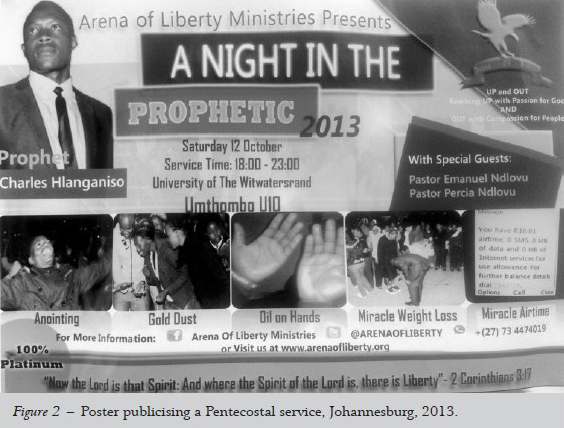
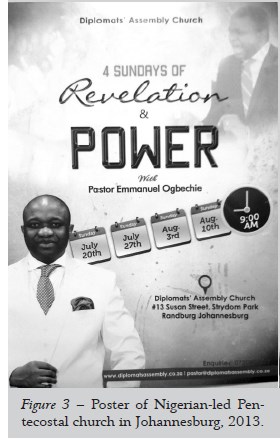
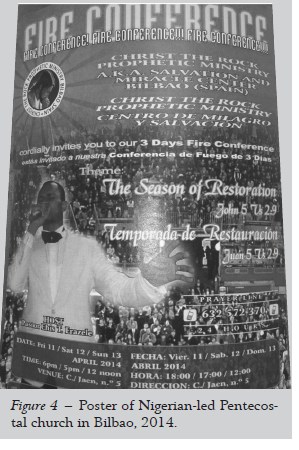
These posters hold the Charismatic speech on change and transformations that can be felt or perceived by living the experience of the announced services. The images behind the words are aligned with the message(s) portrayed by the main protagonist(s). Although posters show static illustrations, pastors figures are often captured in a movement, while talking or making a gesture; alternatively, they may indicate the idea of the seriousness, depth and sobriety of an erudite figure. Worshippers are portrayed as multitudes and also with a strong appeal to ecstatic states by images of people crying, praying with their eyes closed or with their hands and arms in imminent movement. These particular elements were highlighted by Butticci and Esiebo (2013: 6) as part of the aesthetics with which African Pentecostals reinforce their connection with the Kingdom of God and its members, as well as with God himself. The authors explain that this reinforcement is done by contesting (while inhabiting) colonial inheritances of language and religion.
Regarding the social representation of female and male roles, women and men are generally shown in separate spaces, maintaining the notion of gender independence attached to the leading characters. Despite pastors wives borrowing a certain leading status through their relationship with a church leader, they are often entitled to their own space in visual materials, in order for the church to reach the required components of a typical Pentecostal congregation – fellowships of women, elders, youth and children. By showing them separately, women have their figures detached from the general male dominance that is found in the Pentecostal habitus (Lutz 2008). However, such independent roles are also contrasted by posters in which the leading couple is evoked as the head of the congregation. In both locations, depending on the message that is being transmitted, pastors and their wives appear together reproducing the essence of the Christian family: wife and husband united and leading transformations across family issues and society.
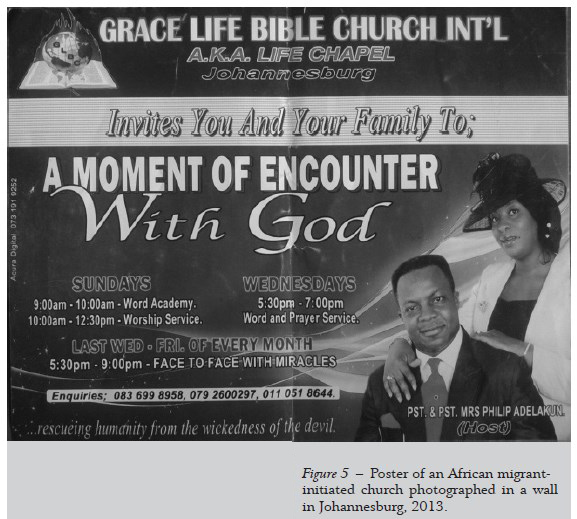
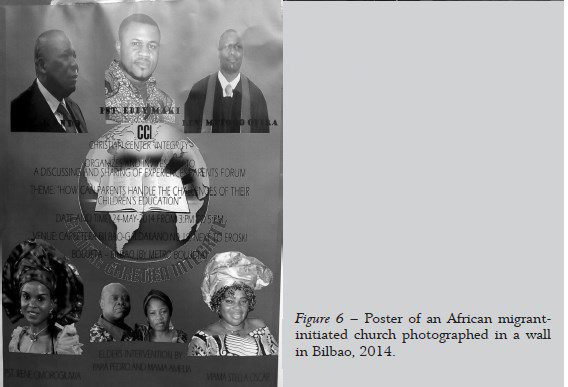
Conclusion: engendering a speech community
The selected churches are places of encounter in religious services led by Nigerian and Congolese pastors, becoming a space for celebrating migrants cultures under the aegis of a Pan-African Christianity. While studying the importance of pastors religious missions and visions, I was introduced not only to the institutional dynamics of these churches, but also to what is conveyed to the public as a particular speech in which pastors are involved as both sufferers and spiritual guides. The persona of the pastor seemed to stand out as the main character to be promoted in visual materials and their biblical expertise and life experiences, as migrants themselves, shaped particular emotional states: fear, happiness, resilience, courage, are translated to the public through visual images of power, where body gestures, scenario and aesthetics conform a recognisable African Pentecostal speech. All of this is captured by cameras and materialised in flyers, videos and posters as a way of conveying what is to be experienced, and how this experience should look like.
Still, besides differences or similarities in body language and styles of personal expression, it was noticed that the methods of preaching are intimately connected with the (in)visibility of the social and cultural contexts of pastors themselves. Without reducing their language or behaviours to ethnicity and considering typical narrative strategies or tools (videos, music, drama, etc.), their personal identities must lie present as both global and local inspirations; this in-between is precisely what makes them a recognisable character to the public sphere worldwide. In this way, drawing on the analytical tradition of Gumperz and Hymes (1972), posters can be understood as the materialisation of the speech community engendered simultaneously by global features of African Pentecostalism and the local faces of congregations. A (de)localised form for sharing practices, evidencing social status, gender roles and relationships, these printed materials are a communication tool that speaks for the congregation as well as for other African Pentecostal fellows. Through these images, church leaders invite the observer to experience emotional states; they provide a taste of what may happen, by showing what has already happened or is re-drawn from African Pentecostal imagery. This speech community is only possible because such images are framed in a symbolic language that is socially accepted, conforming to collectively agreed norms as parts of protocols that attribute a certain solemnity to the contexts. Only what is permitted is possibly recorded or encrypted into the congregations history, defining the image through which the congregation intends to represent itself (Bourdieu and Bourdieu 1965). A leader gifted with supernatural powers, a successful religious entrepreneur, a prosperous migrant, an active born-again Christian, all these roles captured in images help to compose the Pentecostal discourse of transformation.
REFERENCES
ADOGAME, Afe, 2010, Transnational migration and Pentecostalism in Europe, Penteco-Studies: An Interdisciplinary Journal for Research on the Pentecostal and Charismatic Movements, 9 (1): 56-73. [ Links ]
ANDERSON, Alan, 2000, Evangelism and the growth of Pentecostalism in Africa, available at < artsweb.bham.ac.uk/aanderson/publications/evangelism_and_the_growth_of_pen.htm > (last access in October 2017). [ Links ]
BAETA, Christian, 1967, Christianity and healing, Journal of Religious Studies, 1: 19. [ Links ]
BOURDIEU, Pierre, and Marie-Claire BOURDIEU, 1965, The peasant and photography, Ethnography, 5 (4): 601-616, available at < http://journals.sagepub.com/doi/pdf/10.1177/1466138104050701 > (last access in October 2017). [ Links ]
BUTTICCI, Annalisa, and Andrew ESIEBO, 2013, Na God: Aesthetics of African Charismatic Power. Padova, Turato Press. [ Links ]
CAZARIN, Rafael, 2015, Religion, Emotions and Social Transformation along Migratory Processes: The Cases of African Church Leaders in Spain and South Africa, Bilbao, University of the Basque Country, doctoral thesis. [ Links ]
CAZARIN, Rafael, and Andrés DAVILA, 2014, Religiosidad y (re)producción audiovisual: representaciones sociales en sonidos e imágenes de un culto pentecostal africano, Gazeta de Antropología, 30 (1): art. 6, available at < http://www.gazeta-antropologia.es/?p=4420 > (last access in October 2017). [ Links ]
CSORDAS, Thomas J., 2002, Body / Meaning / Healing. New York, Palgrave Macmillan. [ Links ]
DUSZAK, Anna, 1998, Academic writing in English and Polish: comparing and subverting genres, International Journal of Applied Linguistics, 8 (2): 191-213, available at < http://onlinelibrary.wiley.com/doi/10.1111/j.1473-4192.1998.tb00129.x/epdf > (last access in October 2017). [ Links ]
GARBIN, David, 2013, The visibility and invisibility of migrant faith in the city: Diaspora religion and the politics of emplacement of Afro-Christian churches, Journal of Ethnic and Migration Studies, 39 (5): 677-696. [ Links ]
GEERTZ, Clifford, 1973, Religion as a cultural system, in C. Geertz, The Interpretation of Cultures. New York, Basic Books, 87-125. [ Links ]
GERLOFF, Roswith, 1999, The significance of the African Christian Diaspora in Europe, Journal of Religion in Africa, 29 (1): 115-120. [ Links ]
GUMPERZ, John, 1968, The speech community: a reader, in A. Duranti (ed.), Linguistic Anthropology: A Reader, 66-73. [ Links ]
GUMPERZ, John, and Dell HYMES (eds.), 1972, Directions in Sociolinguistics: The Ethnography of Communication. New York, Holt, Rinehart and Winston. [ Links ]
HOLLENWEGER, Walter, 2004, An introduction to Pentecostalisms, Journal of Beliefs and Values, 25 (2): 125-137. [ Links ]
HYMES, Dell, 1974, Foundations in Sociolinguistics: An Ethnographic Approach. Philadelphia, University of Pennsylvania Press. [ Links ]
KALU, Ogbu, 2003, Pentecostal Charismatic reshaping of the African religious landscape in the 1990s, Mission Studies, 20 (1): 84-109. [ Links ]
LUTZ, Catherine, 2008, Engendered emotion: gender, power, and the rhetoric of emotional control in American discourse, in M. Greco and P. Stenner (eds.), Emotions: A Social Science Reader, London, Routledge, 63-70. [ Links ]
MacDOUGALL, David, 1997, The visual in anthropology, in M. Banks and H. Morphy (eds.), Rethinking Visual Anthropology. London, Newhaven Press, 276-295. [ Links ]
MARSHALL-FRATANI, Ruth, 1998, Mediating the global and local in Nigerian Pentecostalism, Journal of Religion in Africa, 28 (3): 278-315. [ Links ]
MEYER, Birgit, 2015, Picturing the invisible: visual culture and the study of religion, Method & Theory in the Study of Religion, 27 (4-5): 333-360. [ Links ]
OMONIYI, Tope, and Joshua A. FISHMAN, 2006, Explorations in the Sociology of Language and Religion. Amsterdam, John Benjamins Publishing. [ Links ]
STURKEN, Marita, and Lisa CARTWRIGHT, 2009, Practices of Looking: An Introduction to Visual Culture. Oxford, Oxford University Press (2nd edition). [ Links ]
SWALES, John, 1990, Genre Analysis: English in Academic and Research Settings. Cambridge, Cambridge University Press. [ Links ]
VAN DIJK, Rijk, 2002, The soul is the stranger: Ghanaian Pentecostalism and the diasporic contestation of flow and individuality , Culture and Religion, 3 (1): 49-66. [ Links ]
NOTES
[1] This paper emerged from a doctoral thesis (Cazarin 2015) carried out within the PhD program Models and Areas of Research in Social Sciences at the Department of Sociology of the University of the Basque Country, in Bilbao, Spain. The fieldwork was funded by a Predoc / Gobierno Vasco 2011-15 doctoral fellowship.
[2] See also Gumperz and Hymes (1972).














